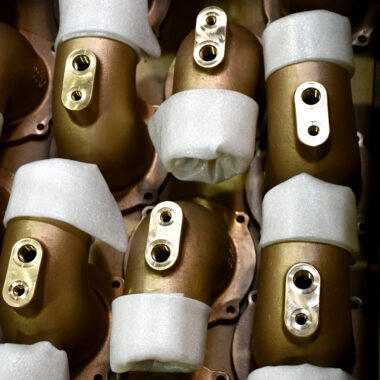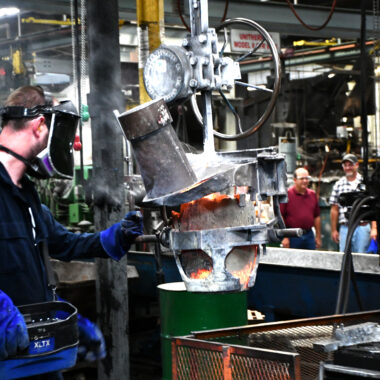Understanding Aluminum Casting: Proven Techniques to Enhance Manufacturing Effectiveness
Understanding Aluminum Casting: Proven Techniques to Enhance Manufacturing Effectiveness
Blog Article
Discovering the Different Methods of Aluminum Casting: A Comprehensive Overview
Light weight aluminum casting stands as a basic procedure in the creation of countless products we experience daily, from complex automobile parts to home fixtures. Recognizing the varied methods used in light weight aluminum casting is essential for suppliers seeking precision and efficiency in their production processes - aluminum casting. As we get started on this expedition of the numerous techniques associated with light weight aluminum spreading, we reveal a world where technology and tradition merge to shape the items that form our modern-day globe
Sand Spreading Approach
Using among the oldest and most extensively utilized techniques in aluminum spreading, the sand casting method entails developing mold and mildews from a blend of sand and a binder material. This technique is extremely functional, economical, and ideal for producing a wide variety of dimensions and shapes, making it a popular choice in numerous industries.

Aluminum, heated up to its melting factor, is after that put right into the mold and mildew, filling the cavity. After cooling and solidifying, the sand mold is broken away, exposing the aluminum spreading. This method enables the production of complex geometries and is fit for both high and low quantity production runs.
Investment Casting Technique
Having actually discovered the sand spreading method, a refined approach to light weight aluminum casting is the investment spreading technique, which uses distinctive benefits in regards to accuracy and surface finish. Investment casting, additionally referred to as lost-wax spreading, is a process that involves producing a wax pattern that is coated with a ceramic shell. Once the covering is dried and set, it is heated to remove the wax, leaving behind a hollow ceramic mold and mildew. Molten light weight aluminum is then put right into the tooth cavity, filling up the mold and mildew to create the desired component.
One of the primary benefits of investment spreading is its capability to create intricate forms with high precision and complex details. The process permits thin wall surfaces, sharp edges, and great surface coatings that call for marginal post-processing. Additionally, investment casting is known for its superb dimensional accuracy and tight resistances, making it a favored approach for generating parts that call for limited requirements. On the whole, the financial investment casting method is a effective and versatile approach for producing high-grade aluminum parts.
Long-term Mold Process

One of the vital advantages of the Long-term Mold Refine is its ability to produce parts with a finer grain framework, resulting in improved mechanical properties. By leveraging the Irreversible Mold Refine, suppliers can achieve cost-effective manufacturing of light weight aluminum parts with outstanding dimensional check this precision and surface area coating.
Die Casting Strategy
As opposed to the Permanent Mold Refine, the Die Casting Technique for aluminum casting involves making use of a multiple-use steel mold to create complex get rid of high dimensional accuracy. This method is commonly utilized in various markets as a result of its ability to successfully manufacture complicated forms with thin wall surfaces and superb surface area coatings.
Die casting typically starts with the preparation of the steel mold and mildew, which is then sprayed with a lubricant to assist in the removal of the solidified aluminum. The mold and mildew is shut, and molten aluminum is infused under high stress into the cavity. As soon as the aluminum strengthens and cools, the mold and mildew opens, exposing the completed component.
One of the crucial advantages of die spreading is its high production price, making it an affordable solution for large production. Furthermore, components created with die spreading show premium stamina and longevity compared to those made via other casting methods. This technique is especially ideal for applications calling for detailed designs, tight resistances, and high repeatability.
Centrifugal Spreading Approach
Just how can the Centrifugal Spreading Approach improve the effectiveness and top quality of light weight aluminum casting procedures? Centrifugal casting is a technique that uses centrifugal pressure to distribute molten metal right into a mold and mildew tooth cavity. This method uses numerous advantages over typical casting approaches.
One key benefit is the superior quality of the spreadings produced. The centrifugal pressure helps to get rid of porosity by pushing any kind of gas or impurities towards the facility of the spreading, resulting in a denser and much more consistent final item (aluminum casting). In addition, the rotational activity of the mold and mildew makes sure a more also circulation of the molten metal, bring about enhanced mechanical properties and minimized defects
In Addition, the Centrifugal Spreading Technique is recognized for its efficiency. The fast solidification price accomplished via this process can add to reduced cycle times, making it an economical remedy for high-volume production. The method enables for the spreading of elaborate forms and thin-walled parts with ease, expanding the layout possibilities for makers. In final thought, web the Centrifugal Casting Approach stands apart as a dependable method for enhancing both the performance and high quality of light weight aluminum spreading procedures.

Verdict
To conclude, the different methods of light weight aluminum casting supply distinct benefits and features for various applications. Sand spreading offers convenience and cost-effectiveness, financial investment spreading enables intricate designs, irreversible mold process guarantees top notch coatings, die casting gives high production rates, and centrifugal spreading generates high-strength elements. Recognizing the differences in between these approaches can aid producers choose the most appropriate strategy for their certain spreading requirements.
Having discovered the sand casting method, a refined strategy to light weight aluminum spreading is the financial investment spreading technique, which provides distinctive advantages in terms of precision and surface area coating. Investment casting, additionally understood as lost-wax spreading, is a process that includes developing a wax pattern that is coated with a ceramic shell.How can the Centrifugal Casting Approach enhance the effectiveness and high quality of aluminum spreading procedures? In conclusion, the Centrifugal Spreading Technique stands out as a trusted strategy for improving both the efficiency and high quality of light go weight aluminum casting processes.
Sand spreading supplies adaptability and cost-effectiveness, financial investment spreading permits for intricate designs, permanent mold and mildew process makes certain high-grade coatings, pass away casting provides high manufacturing prices, and centrifugal spreading generates high-strength parts.
Report this page